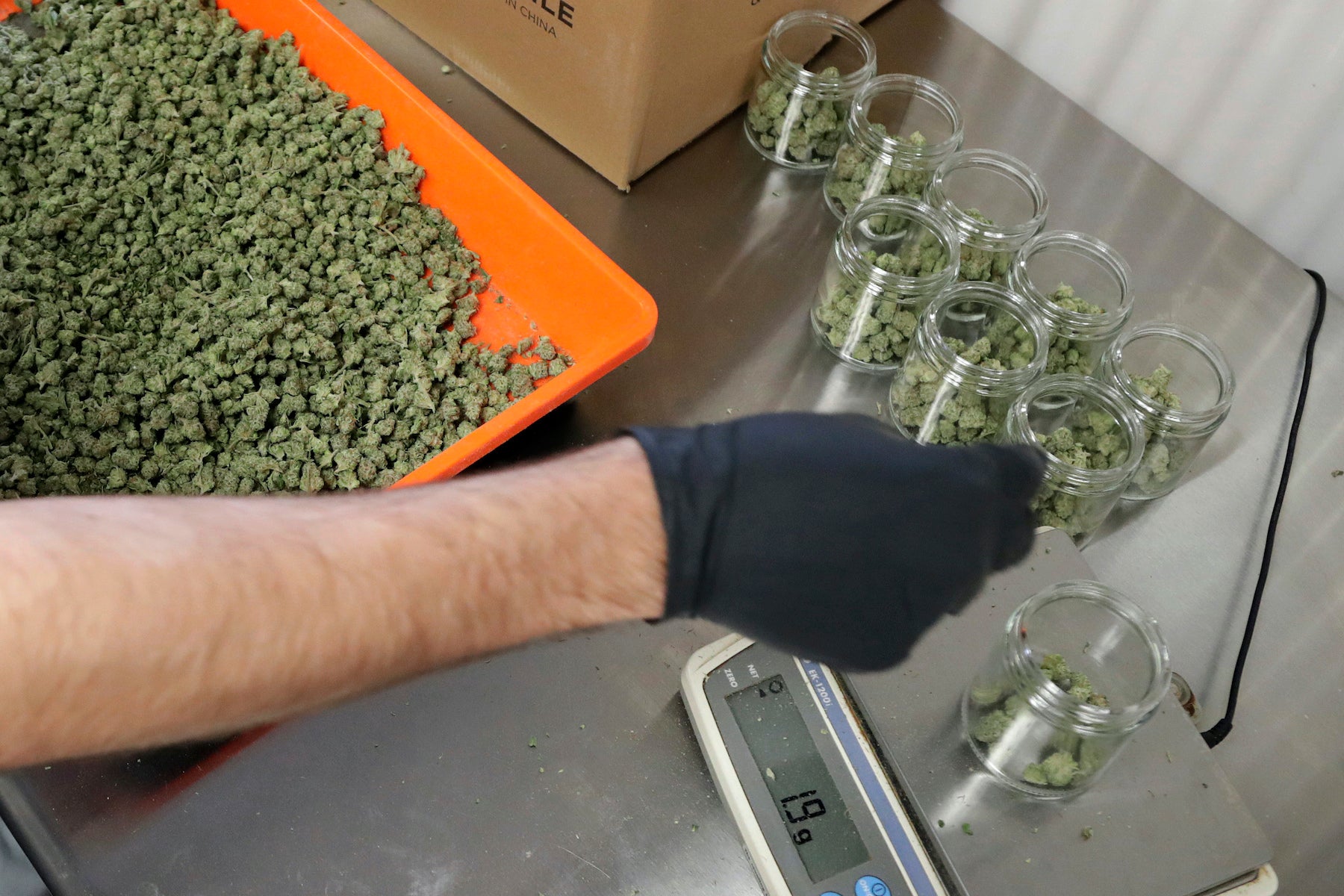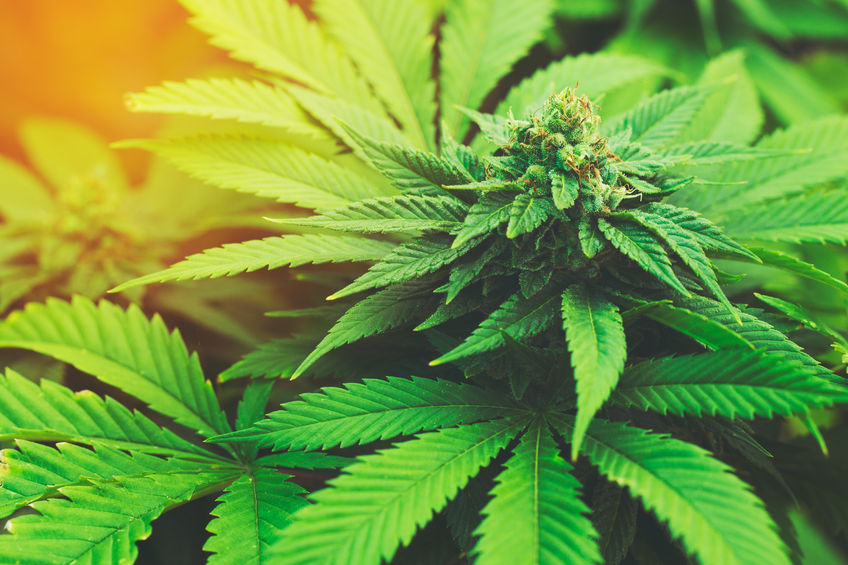Minnesota
As western Minnesota counties regulate cannabis use, bigger questions arise of who sells it

GRANITE FALLS
—
Yellow Medicine County
joined the growing list of area counties adopting ordinances to regulate the use of cannabis and cannabis products, and with the action on Nov. 14 came the bigger questions now confronting all area counties.
“How many cannabis facilities and licenses do you need in a community,” asked Liz Auch, director of Countryside Public Health. She told the
Yellow Medicine County Board of Commissioners
that her chief concern as a public health nurse is this: “How accessible are we going to make this product?”
How many licenses to make available, and how to decide who will hold those licenses, are the questions now surfacing as counties begin the process of regulating cannabis to conform to the new state law opening the way for its sale and use.
Adult use and possession became legal Aug. 1, and the state
Office of Cannabis Management
expects the first retail sales outside of tribal nations to begin in the first quarter 2025.
Yellow Medicine and Chippewa counties have both adopted ordinances regulating cannabis use. Countryside Public Health assisted the counties in its service area to develop the ordinance. Swift County is now in the process of considering the ordinance, said Auch. Big Stone and Lac qui Parle counties are the other counties served by Countryside.
The ordinance prohibits the use of cannabis in public areas, such as parks. “This has a very similar feel to the tobacco ordinance,” said Yellow Medicine County Commissioner Ron Antony as the commissioners opened a public hearing on the ordinance. They subsequently adopted it on an unanimous vote after hearing no comments against it.
The ordinance makes it a petty misdemeanor to consume cannabis in public spaces, according to Sheriff Bill Flaten in response to a question about what the ordinance would do. “We are not going to put anybody in jail for it.”
The Sheriff’s Office will respond to calls or complaints about possible violations. The sheriff said it’s most likely that responding officers will ask offenders “to please go somewhere else and not use it in this public area.”
He described the ordinance as a tool, no different than the county’s current regulation banning alcohol consumption in parks.
The new state law requires that local governments provide at least one license for retail sale of cannabis and cannabis products for every 12,500 residents. That means Yellow Medicine County must provide at least one license, but it could open the way for more. Municipalities in the county can also allow for additional licensed vendors within their boundaries.
David Samson / Forum News Service file photo
Auch pointed out that there are both economic and health issues to consider. Most rural communities are interested in helping grocery stores, gas stations and other businesses remain and thrive. Will they take the same approach toward cannabis in supporting the retail outlets as part of the community’s economic infrastructure?
It’s material for thoughtful discussion, she said. “How many do you need?”
“My answer to that one, Liz, is as little as we have to allow,” Antony responded.
“What makes a public health person happy might not make a business owner who is trying to thrive in a community happy,” Auch said.
Yellow Medicine and Chippewa counties will now work with Countryside Public Health to determine how many licenses they will make available, and what criteria to consider in selecting who gets them.
Both counties have already heard interest from individuals looking for licenses to sell cannabis at retail establishments. Five or six inquiries have already been made in Yellow Medicine County, according to information at the meeting.
Chippewa County has not made any decisions yet on licensing and is waiting for more information to come from the Minnesota Office of Cannabis Management and rule-making bodies at the state level, County Auditor/Treasurer/Coordinator Michelle May told the West Central Tribune.
Along with private businesses, municipalities as well as counties could get into the business of cannabis sales. The city of Benson is currently exploring the possibility of selling cannabis at its municipal liquor store, according to Kyle Harris, city manager.
There have been some conversations exploring the possibilities and what that might look like, but no decisions have been made, Harris said. There have also been discussions about selling the low-potency, edible gummies that are now legal at the liquor store to see how that goes, he added.
Antony attended a recent district meeting for the Minnesota Association of Counties, and said he learned that some counties are also looking at the possibility of opening their own cannabis stores. It would allow them to control its sale just as municipal liquor stores allow municipalities to control alcohol sales and generate revenues for city coffers from it.

Minnesota
Donald Trump Falsely Tells Supporters He Won Minnesota in 2020
Minnesota
Back on the road: Timbers visit Minnesota United FC | PTFC

Fresh off their 4-2 comeback win against the Earthquakes on Wednesday, the Portland Timbers (11th, 3-6-4, 13pts) get back on the road to take on Minnesota United FC (2nd, 6-2-3, 21pts). It’s their first encounter in 2024, and The Loons are flying high having won three of their last four matches, good enough to put them second in the conference. The Timbers will look to harness the second half energy from Wednesday’s win to pull out their second road victory of the season this Saturday.
Kickoff from Allianz Field is set for 5pm PT.
🖥️ TV/Streaming: Live coverage available in English and Spanish on MLS Season Pass on Apple TV. Enjoy 25% off for the rest of the season when you subscribe today.
🍺 Pub Party: We’re gathering at Hop Haven to cheer on the boys! Click below for more information.
Minnesota
Women, kids and the future of fishing: thoughts off the Minnesota opener

The goodwill that exists among Minnesotans for conservation of the state’s natural resources and especially for preservation of outdoor traditions — fishing among them — is unbounded.
That was among my thoughts last weekend during the inland walleye and northern pike opener, which some friends and I spent on Lake Winnibigoshish (“Winnie”) while fishing out of McArdle’s Resort on Winnie and nearby Paradise Resort on Moose Lake.
On the season’s first day, Winnie was loaded with boats, most carrying an average of three anglers. An hour’s drive north or so of that giant lake, Upper Red Lake also was crowded, as were, not far away, Leech and Cass lakes.
Department of Natural Resources conservation officer (CO) Andrew Goodman of Perham concurred the opener was bustling, saying it was the busiest he’s seen in recent memory.
CO Aaron Larson of Tower agreed, reporting a busy opener on Lake Vermilion, while CO John Slatinski IV, working out of Ray, said he couldn’t remember a recent opener as hectic.
Fishing license sales just before the opener were 7% higher than a year ago, confirming the officers’ observations.
While waiting last weekend in long lines at bait shops and at boat launches, and while trolling a quarter-ounce jig in 12 feet of water on the opener (fishing partners Joe Hermes, Steve Vilks, my wife, Jan, and I had good luck), these were two of my observations:
- More women are fishing now than in previous years, a trend that in my view must continue for fishing to remain the state’s premier outdoor activity.
- Perhaps counterintuitively, given the meteoric rise in popularity of competitive fishing in Minnesota among 7th-12th graders, fewer young people appear to be fishing on the opener — and at other times — than has been the case in Minnesota historically. (This could be because many school fishing competitions are for bass, not walleyes.)
The two issues are connected in my view, and how they play out, alone and together, will help determine whether fishing, Minnesota’s premier outdoor pastime, continues to thrive or suffers.
The issue is important to everyone, not just anglers, because fishing is second only to camping in the amount of money ($36 billion) it contributes to the U.S. recreation economy. The funds not only underwrite fisheries management, they help ensure the presence of surface and sub-surface clean water.
According to the Department of Natural Resources, about 20% of anglers in Minnesota are women. That percentage is impressive and might be the highest among all states. But it will have to increase markedly to ensure future generations of kids are exposed to fishing and other outdoor activities in intentional ways.
That’s because women generally have more influence on how a family spends its time than men do. And given that any young kid doing anything outdoors — playing in mud included — is likely to be better off psychologically and emotionally than a kid who stares at a phone or computer all day, more women (and men) of the future will, in my view, have to help kids make healthier choices, including some that include rods, reels and lures.
Diane Scott, a Future Anglers of Minnesota (FAM) board member, believes fishing might hold special promise for a kid’s development.
“Our group probably interacts with 250 kids a year,” Scott said of FAM. “This includes Callan Wagner, my grandson, who was my biggest reason for getting involved with FAM.”
As proud as Scott is of 13-year-old Callan’s developing angling prowess, she’s prouder still of the fundraiser he and other FAM kids participated in. Soliciting pledges for every fish they caught in a winter tournament, Callan raised $6,885 for St. Jude’s Children’s Hospital, while fellow FAM member Khloe Thorson did better still, raising $7,200 for a cancer foundation.
“We challenge our young anglers not only to develop their fishing skills but to help their communities,” Scott said.
Meanwhile, Women Anglers of Minnesota (WAM), the fishing group founded in 1977 to introduce women to the joys of fishing, continues to thrive. On June 8 on Lake Osakis, the group will host its 46th WAM Open Water Fishing Tournament, and members also will volunteer June 15 at Buffalo Days Fishing Klinics for Kids, and June 28 at the Jiggin’ with Kids nationwide virtual fishing tournament.
Impressively, WAM also sponsors 25 high school fishing teams and, in Minnesota, also sponsors the Student Angler Tournament Trail.
Of course, these groups can’t provide outdoor opportunities for all Minnesota kids. Parents also must help attempt to counter the temptations of electronics and social media with outdoor activities. In my experience, as a parent and observer of parents, that can be an uphill climb if a child isn’t brought to a park or similar environment by age 2 or 3, and isn’t soon thereafter taken camping, hiking, biking, fishing or otherwise doing something outdoors.
Which is why the seeming absence on this opener, as on previous openers, of young people is worrying. Not only because the future of fisheries and clean water depend on continued participation by the masses, but because society will benefit if more people spend more time outdoors.
A retired Twin Cities teacher and expert angler, Kay Hawley agrees.
A member of three fishing clubs — Minnesota Valley In-Fisherman, Twin Cities Walleyes Unlimited and WAM — Hawley this weekend is passing on the joy of fishing by helping to host the Minnesota Angler Meet-Up at Vermilion Dam Lodge on Lake Vermilion.
“We have 30 anglers here representing the three clubs, and by joining forces and learning from each other, each of us will have a greater opportunity to positively impact the Minnesota fishing community,” Hawley said.
Then she went fishing, as she should.
-

 World1 week ago
World1 week agoPentagon chief confirms US pause on weapons shipment to Israel
-

 Politics1 week ago
Politics1 week agoRFK Jr said a worm ate part of his brain and died in his head
-

 Politics1 week ago
Politics1 week agoOhio AG defends letter warning 'woke' masked anti-Israel protesters they face prison time: 'We have a society'
-

 News1 week ago
News1 week agoNine Things We Learned From TikTok’s Lawsuit Against The US Government
-

 Politics1 week ago
Politics1 week agoBiden’s decision to pull Israel weapons shipment kept quiet until after Holocaust remembrance address: report
-

 Education1 week ago
Education1 week agoVideo: Police Use Pepper Spray on Protesters on G.W.U.’s Campus
-

 World1 week ago
World1 week agoA look at Chinese investment within Hungary
-

 News1 week ago
News1 week agoThe Major Supreme Court Cases of 2024









/cdn.vox-cdn.com/uploads/chorus_asset/file/25453128/1265758482.jpg)









